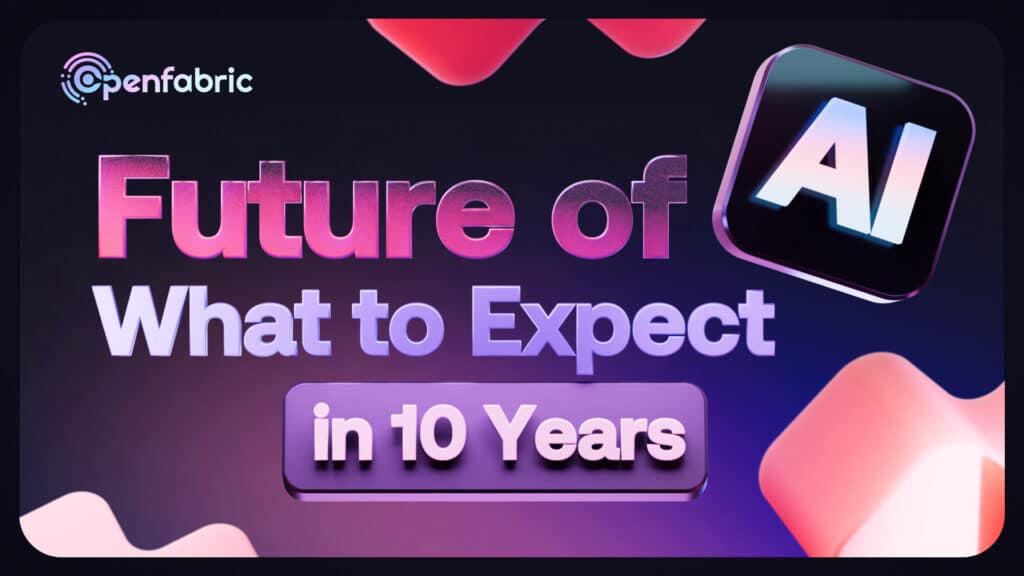
Future of AI: What to Expect in 10 Years
March 22, 202411 minutes read

Years ago, the mere notion of the internet changing our lives seemed fantastical, yet here we are, seamlessly interconnected in ways we never imagined. With advancements in computational power and computer systems, NVIDIA, a global leader in GPU technology, has achieved a remarkable feat by developing the largest chip to date. This takes us back to the transformative transition from the first generation of computers to the fifth. It literally shows the shift from bulky mainframe systems to the widespread presence of computing power in everyday devices such as mobile phones and laptops. NVIDIA’s innovation has played an important role in enabling this evolution. Similarly, the future of AI holds promise for similar breakthroughs in AI. The rapid rise of AI is expected to redefine our existence in profound ways. In this captivating exploration, we delve into the myriad ways AI is set to sculpt the future landscape of humanity.
Some of these are:
- Human-Machine Collaboration
- Advanced Automation
- Smarter Virtual Assistants
- Ethical AI Regulations
- Rapid Medical Advancements
- AI-driven Education
- Enhanced Cybersecurity Measures
Human-Machine Collaboration
In the forthcoming decade, expect a tighter bond between humans and AI. AI systems won’t snatch away human roles; instead, they’ll join forces, enriching human skills and fostering fresh collaborative ventures across diverse fields. Transitioning into this era, humans and AI will work hand in hand. AI won’t overshadow humans; it’ll uplift them, opening doors to novel forms of teamwork and creativity. With AI as a trusty ally, humans will embark on endeavors previously unattainable.
Collaboration will be the cornerstone of future advancements. Humans will wield AI tools to amplify their capabilities, navigating complex tasks with newfound ease. Picture a world where AI acts as a guiding beacon, empowering humans to tackle challenges head-on. This symbiotic relationship between humans and AI will catalyze innovation. Together, they’ll chart unexplored territories, fueled by the synergy between human ingenuity and AI prowess. As they journey onward, expect breakthroughs that redefine the boundaries of possibility.
Transcending conventional boundaries, human-AI collaboration will permeate various sectors. Whether in healthcare, finance, or education, expect to witness the seamless integration of human and AI efforts. This convergence will spark a wave of transformative change, reshaping industries from within.
Furthermore, this collaboration will foster a culture of continuous learning. Humans will absorb insights from AI, honing their skills and adapting to evolving landscapes. In return, AI will learn from human experiences, refining its capabilities to better serve humanity.
The future of AI hinges on its ability to complement human endeavors. Rather than supplanting humans, AI will amplify their impact, ushering in an era of unprecedented collaboration and innovation. Embrace this partnership, for together, humans and AI will chart a course towards a brighter tomorrow.
Advanced Automation
Over the next decade, brace yourselves for a profound transformation in how work gets done. Automation, powered by artificial intelligence (AI), will become the cornerstone of productivity across industries. Mundane, repetitive tasks that once bogged down human workers will now be swiftly handled by intelligent algorithms, shaping the future of AI. This shift promises to streamline operations, boost efficiency, and unleash unprecedented levels of productivity.
Moving from the monotony of manual labor to the dynamism of automated processes will be nothing short of revolutionary. In factories, assembly lines will hum with the precision of AI-guided robotics, seamlessly piecing together products with unrivaled accuracy, showcasing the potential of the future of AI. In offices, administrative duties such as data entry and documentation will be effortlessly managed by AI-driven software, liberating employees to focus on more strategic tasks.
The impact of automation will reverberate across sectors, from manufacturing and finance to healthcare and beyond, shaping the trajectory of the future of AI. In manufacturing, AI-powered machines will not only expedite production but also enhance quality control, minimizing errors and waste. In finance, algorithms will analyze vast datasets with lightning speed, enabling more informed decision-making and mitigating risks. Even in healthcare, AI applications will revolutionize patient care, optimizing treatment plans and diagnosis through advanced analytics.
But it doesn’t involve taking your jobs away!
However, this transformation isn’t merely about replacing human labor with machines; it’s about augmenting human potential in the future of AI. By delegating routine tasks to AI, employees will have the bandwidth to engage in higher-order thinking, creativity, and innovation. Rather than being bogged down by the mundane, they’ll be empowered to tackle complex challenges, driving progress and growth within their organizations. The benefits of automation extend beyond the confines of individual enterprises. As productivity soars, economies will experience a ripple effect of growth and prosperity, underlining the significance of the future of AI. With AI at the helm, businesses will operate more efficiently, leading to cost savings that can be reinvested in research, development, and employee training. This virtuous cycle of innovation and reinvestment will fuel economic expansion and create new opportunities for employment and advancement.
Of course, navigating this brave new world of automation will require foresight and adaptability. Organizations must invest in reskilling and upskilling initiatives to equip their workforce with the digital competencies needed to thrive in an AI-driven landscape. Similarly, policymakers must enact forward-thinking regulations to ensure that the benefits of automation are equitably distributed and that ethical considerations are paramount in AI development and deployment, shaping the ethical future of AI.
Smarter Virtual Assistants
In the forthcoming decade, virtual assistants will undergo significant advancements, becoming even smarter and seamlessly woven into our daily lives. They will offer proactive support and better anticipate users’ needs. Virtual assistants will become smarter, constantly learning and adapting to provide more personalized assistance. This means they will understand your preferences better and offer solutions tailored to your specific needs. These assistants will seamlessly integrate into various aspects of our lives, from home to work and everywhere in between. Whether it’s managing your calendar, helping with tasks, or providing timely reminders, they will be there every step of the way, shaping the future of AI in our lives.
Traditional virtual assistants wait for commands but future versions will take a proactive approach. They will anticipate your needs based on your behavior patterns and offer assistance before you even realize you need it. Communication with virtual assistants will feel more natural and intuitive. They will understand colloquial language, accents, and context, leading to smoother interactions. Future virtual assistants will be adept at handling multiple tasks simultaneously. Whether it’s scheduling appointments while drafting emails or providing real-time updates while you’re on the go, they will excel at multitasking to keep up with your busy lifestyle, heralding the future of AI-driven assistance.
Users will have the ability to personalize their virtual assistant’s interface to suit their preferences. Whether it’s choosing a voice, adjusting the appearance, or customizing the layout, you’ll have full control over how you interact with your assistant. Virtual assistants will continually learn and improve over time. They will analyze user feedback and interactions to refine their algorithms and provide even more accurate and relevant assistance. Virtual assistants will be accessible across a wide range of devices and platforms, ensuring you have access to them whenever and wherever you need assistance.
Ethical AI Regulations
As AI continues to advance, it’s essential to establish clear ethical guidelines and regulations to ensure fair and responsible use. Transitioning into the next decade, the focus will intensify on developing frameworks that prioritize ethical considerations in AI development and deployment.
Key stakeholders, including governments, industry leaders, and researchers, recognize the pressing need to address ethical concerns surrounding AI. With AI becoming increasingly integrated into various aspects of society, from healthcare to finance, proactive measures are essential to mitigate potential risks and ensure positive outcomes for all stakeholders. Ethical AI regulations will serve as guardrails, guiding the development and deployment of AI technologies. These regulations will outline acceptable practices and set boundaries to prevent misuse or unintended consequences. By adhering to these guidelines, developers and organizations can cultivate trust and confidence in AI systems among users and stakeholders.
Moreover, ethical AI regulations will promote transparency and accountability in AI development processes. Companies will be required to disclose how AI algorithms function, including data sources, training methods, and potential biases. This transparency fosters trust and allows users to make informed decisions about AI-powered products and services.
Fairness and Equity
Additionally, ethical AI regulations will prioritize fairness and equity in AI applications. Measures will be put in place to address biases and discrimination that may arise from AI algorithms. By proactively identifying and mitigating biases, AI systems can contribute to creating more inclusive and equitable outcomes for diverse populations. Ethical AI regulations will emphasize the importance of data privacy and security. As AI relies heavily on data, it’s essential to safeguard individuals’ privacy rights and prevent unauthorized access or misuse of personal information. Regulations will establish strict standards for data handling and require robust security measures to protect sensitive data from breaches or cyberattacks.
Transitioning into the next decade, collaboration and cooperation among stakeholders will be paramount in shaping ethical AI regulations. Governments, industry players, academia, and civil society must work together to develop comprehensive frameworks that balance innovation with ethical considerations. By fostering a collaborative approach, we can ensure that AI technologies benefit society while minimizing potential risks and harms. The future of AI hinges on the establishment of robust ethical guidelines and regulations. By prioritizing ethical considerations in AI development and deployment, we can harness the full potential of AI while safeguarding against potential risks and harms. Navigating ethical AI requires proactive measures, transparency, and collaboration among stakeholders to ensure responsible and fair innovation in the years to come. Read Openfabric’s article on Ethical considerations in Artificial intelligence.
The Future Of Ai Promises Rapid Medical Advancement
In the next decade, the future of healthcare will witness a profound transformation, fueled by the integration of artificial intelligence (AI). AI’s pivotal role in this evolution lies in its ability to expedite medical advancements, enabling early detection of diseases, tailoring treatment plans to individual needs, and optimizing medical procedures to enhance patient outcomes.
Firstly, AI will revolutionize disease detection by enabling early identification through sophisticated algorithms analyzing vast amounts of medical data. This proactive approach allows healthcare professionals to intervene swiftly, potentially preventing the progression of diseases and improving prognosis. By swiftly identifying anomalies in medical imaging or analyzing genetic markers, AI empowers healthcare providers to make informed decisions promptly.
Furthermore, personalized treatment plans will become increasingly prevalent, thanks to AI’s capacity to analyze patient data comprehensively. By considering individual factors such as genetic predispositions, lifestyle choices, and medical history, AI algorithms can recommend treatment options tailored to each patient’s unique circumstances. This personalized approach enhances treatment effectiveness while minimizing adverse effects, ultimately improving patient outcomes. (See Openfabric’s Drug Discovery application)
Moreover, AI streamlines medical processes, enhancing efficiency and reducing operational burdens on healthcare systems. Through automation and optimization of tasks such as appointment scheduling, medical record management, and inventory tracking, AI frees up healthcare professionals to focus more on patient care. By minimizing administrative overhead, AI ensures smoother operations within healthcare facilities, leading to shorter wait times and improved patient satisfaction.
Transitioning into the future, AI will continue to play an increasingly prominent role in healthcare, driving innovation and reshaping the medical landscape. As technology advances and AI algorithms become more sophisticated, the possibilities for improving patient care are virtually limitless. By embracing AI-driven solutions, healthcare systems can evolve to meet the growing demands of an aging population and increasingly complex medical challenges.
AI-driven Education
In the next decade, education will undergo a profound transformation thanks to AI-driven adaptive learning platforms, shaping the future of AI in education. These platforms will tailor learning experiences to match each student’s unique strengths, weaknesses, and preferred learning style. Imagine a classroom where every student receives personalized instruction, enabling them to excel at their own pace.
Transitioning from traditional one-size-fits-all teaching methods, AI-powered platforms will offer a dynamic approach to education, heralding the future of AI integration. No longer will students feel left behind or held back by the pace of the class. Instead, they will engage with material that is precisely calibrated to their individual needs.
One of the key benefits of AI in education is its ability to adapt in real-time, paving the way for the future of AI-driven learning. As students interact with the platform, AI algorithms analyze their performance, identifying areas where they excel and areas where they struggle. This feedback loop allows the platform to adjust the difficulty level of tasks and provide additional support where needed.
Moreover, AI-powered platforms will make learning more interactive and engaging, representing the cutting edge of the future of AI in education. Rather than passively consuming information, students will participate in immersive experiences that stimulate their curiosity and creativity. For example, virtual reality simulations could transport students to historical events or scientific phenomena, bringing learning to life in ways previously unimaginable.
Furthermore, AI can assist educators in identifying patterns and trends in student performance that may not be immediately apparent, showcasing the future potential of AI in educational settings. By analyzing data from thousands of students, AI algorithms can uncover insights that inform teaching strategies and curriculum development. This data-driven approach ensures that educational resources are allocated effectively, maximizing student learning outcomes.
Enhanced Cybersecurity Measures
In the foreseeable future, the integration of AI into cybersecurity measures will lead to a significant enhancement in safeguarding digital assets against evolving cyber threats. As cyber attacks become more sophisticated, AI technology will play a pivotal role in bolstering defense mechanisms, promptly detecting and mitigating potential threats.
Firstly, AI algorithms will continuously monitor network activities, identifying anomalies and suspicious patterns indicative of malicious intent. By actively scanning vast amounts of data in real-time, AI-powered systems will swiftly pinpoint potential security breaches, enabling rapid response and mitigation strategies. AI-driven cybersecurity solutions will employ predictive analytics to anticipate potential vulnerabilities before they can be exploited by cybercriminals. Through advanced machine learning algorithms, these systems will analyze historical data to forecast emerging threats, enabling preemptive measures to fortify cyber defenses proactively. AI-enabled cybersecurity platforms will enhance incident response capabilities by automating threat detection and response procedures. Through autonomous decision-making capabilities, these systems will execute predefined protocols to mitigate cyber threats swiftly, minimizing the impact of attacks on organizational infrastructure and data integrity.
Furthermore, AI algorithms will facilitate adaptive security measures, dynamically adjusting defense strategies based on evolving threat landscapes. By continuously learning from new data inputs, AI-driven systems will optimize cybersecurity protocols to effectively counter emerging cyber threats, ensuring robust protection against evolving attack vectors. The integration of AI into cybersecurity measures represents a paradigm shift in safeguarding digital assets against an increasingly complex threat landscape. As cybercriminal tactics continue to evolve, AI-driven cybersecurity solutions will remain indispensable in safeguarding the integrity and confidentiality of digital assets in the years to come.
These points are only a few of what is expected of Artificial Intelligence in our rapidly evolving world. Stay updated on everything AI with Openfabric. Join in as we collaboratively build the future of the internet and beyond.




